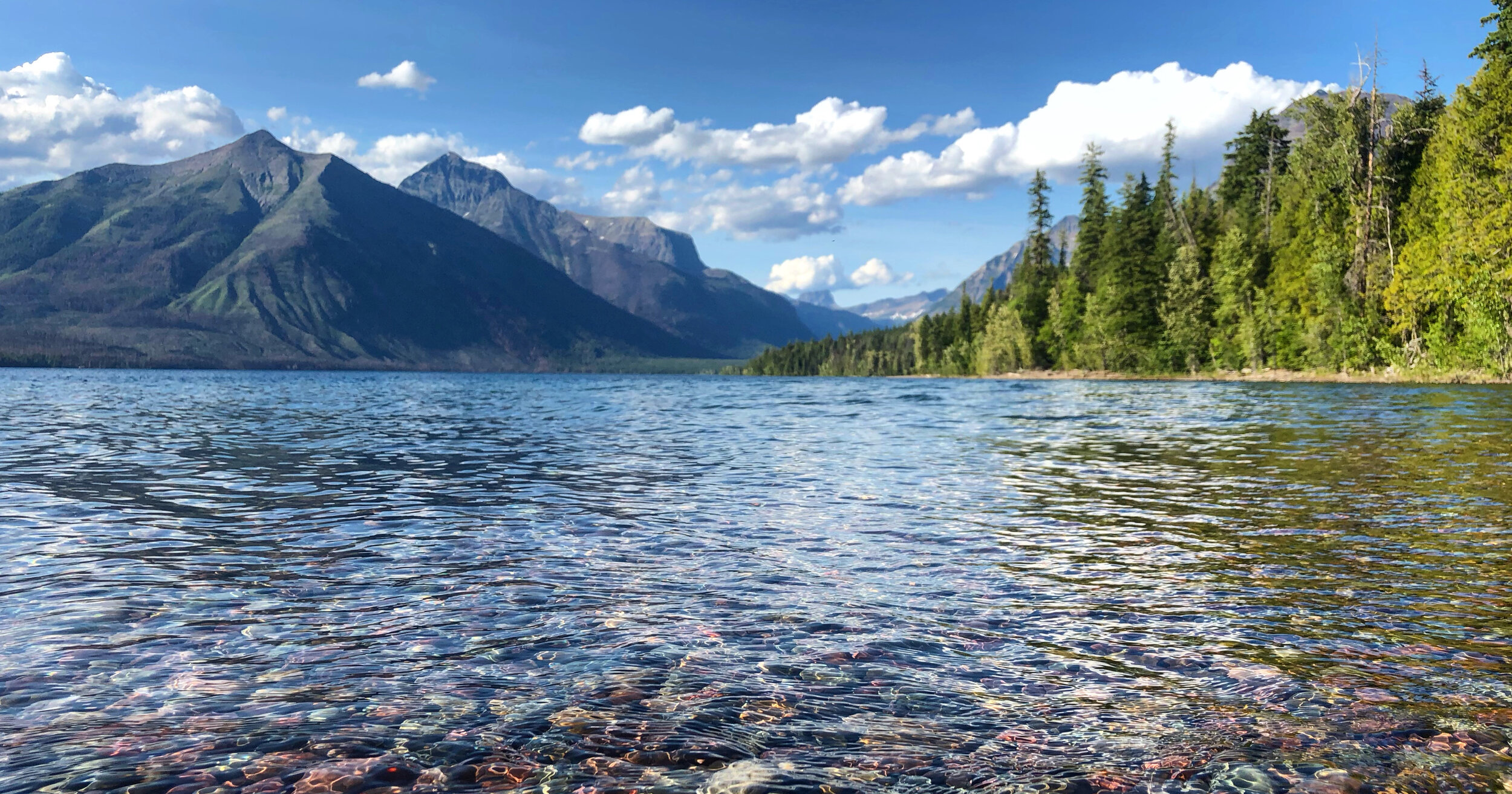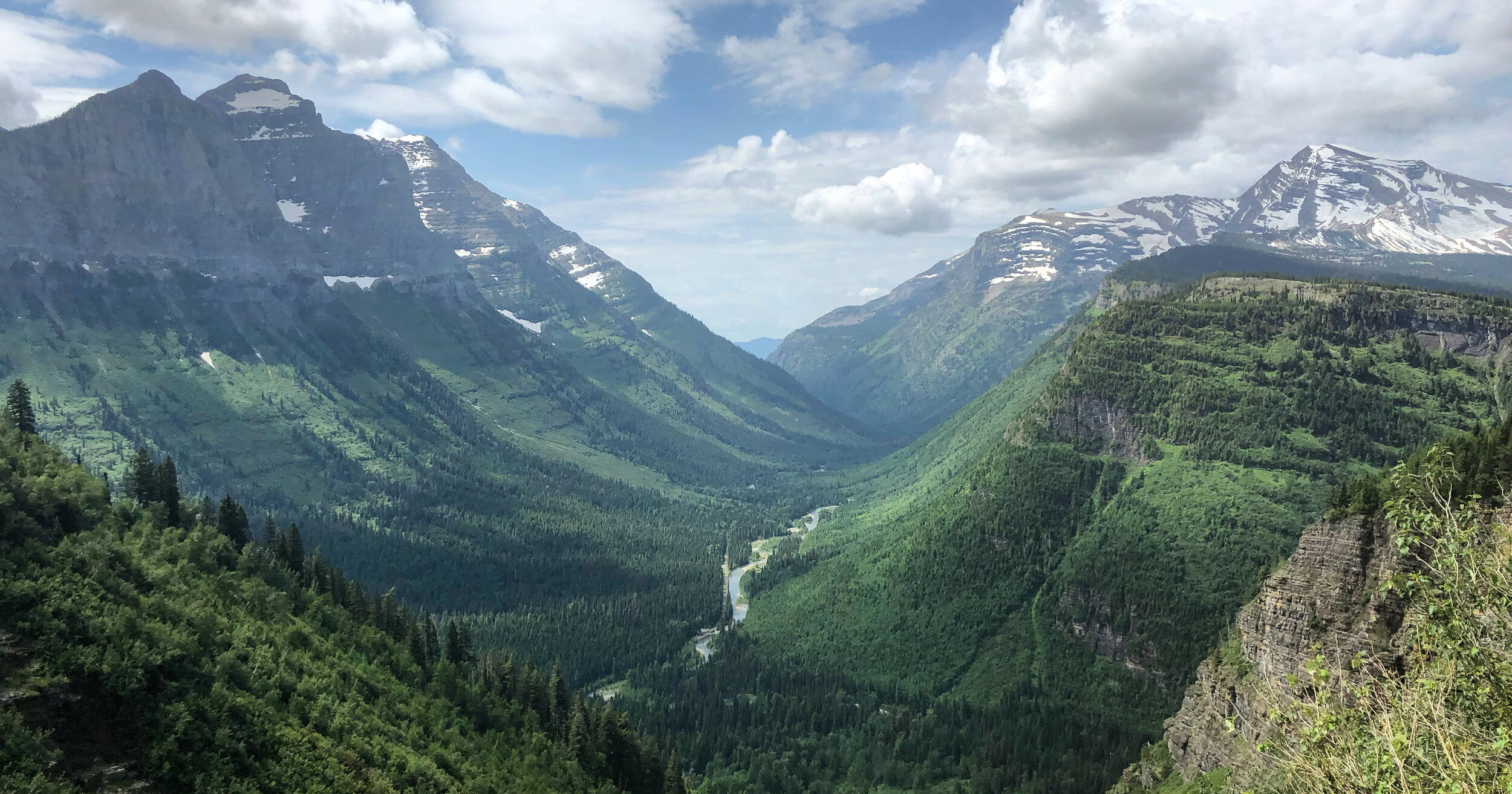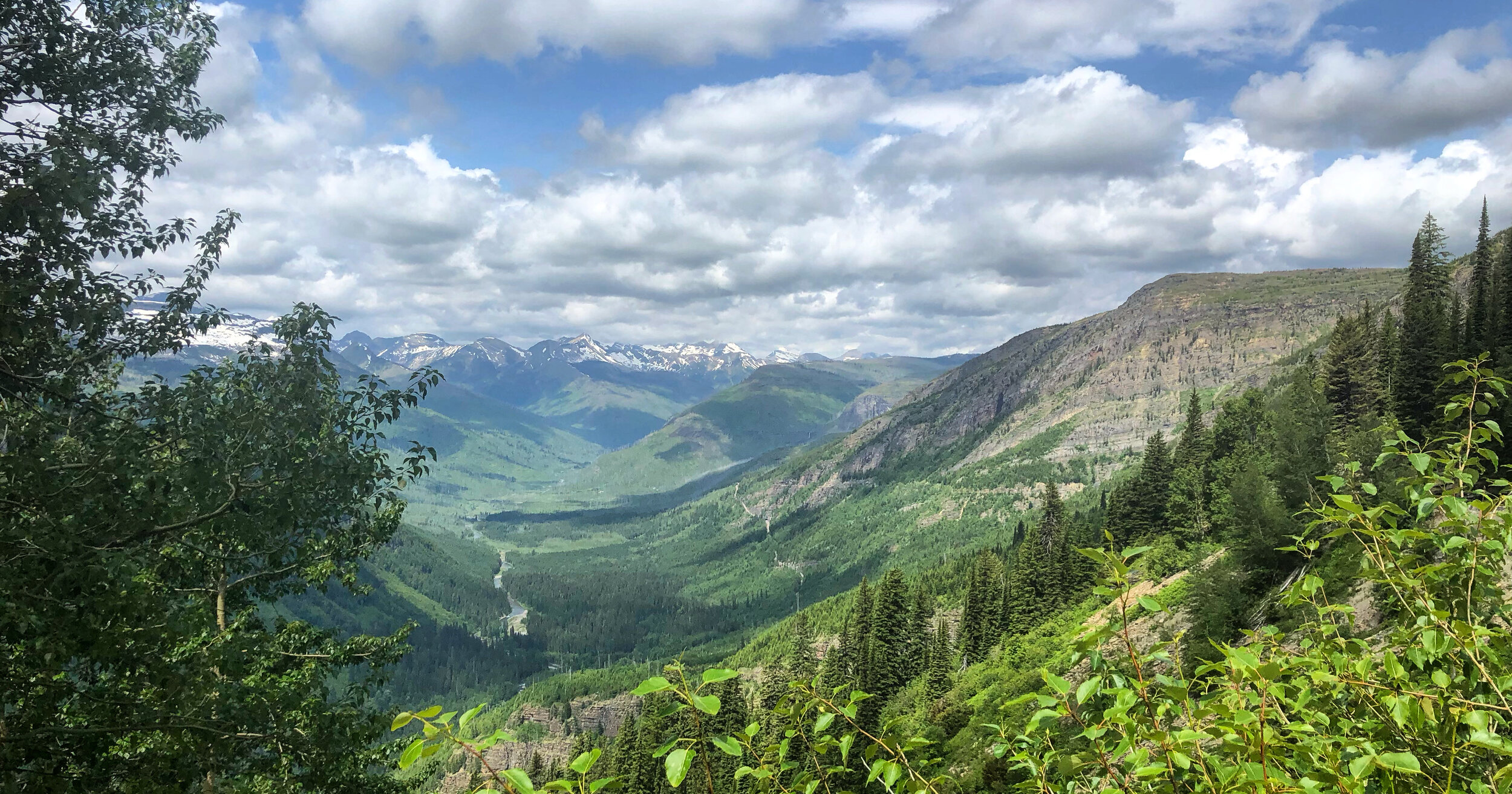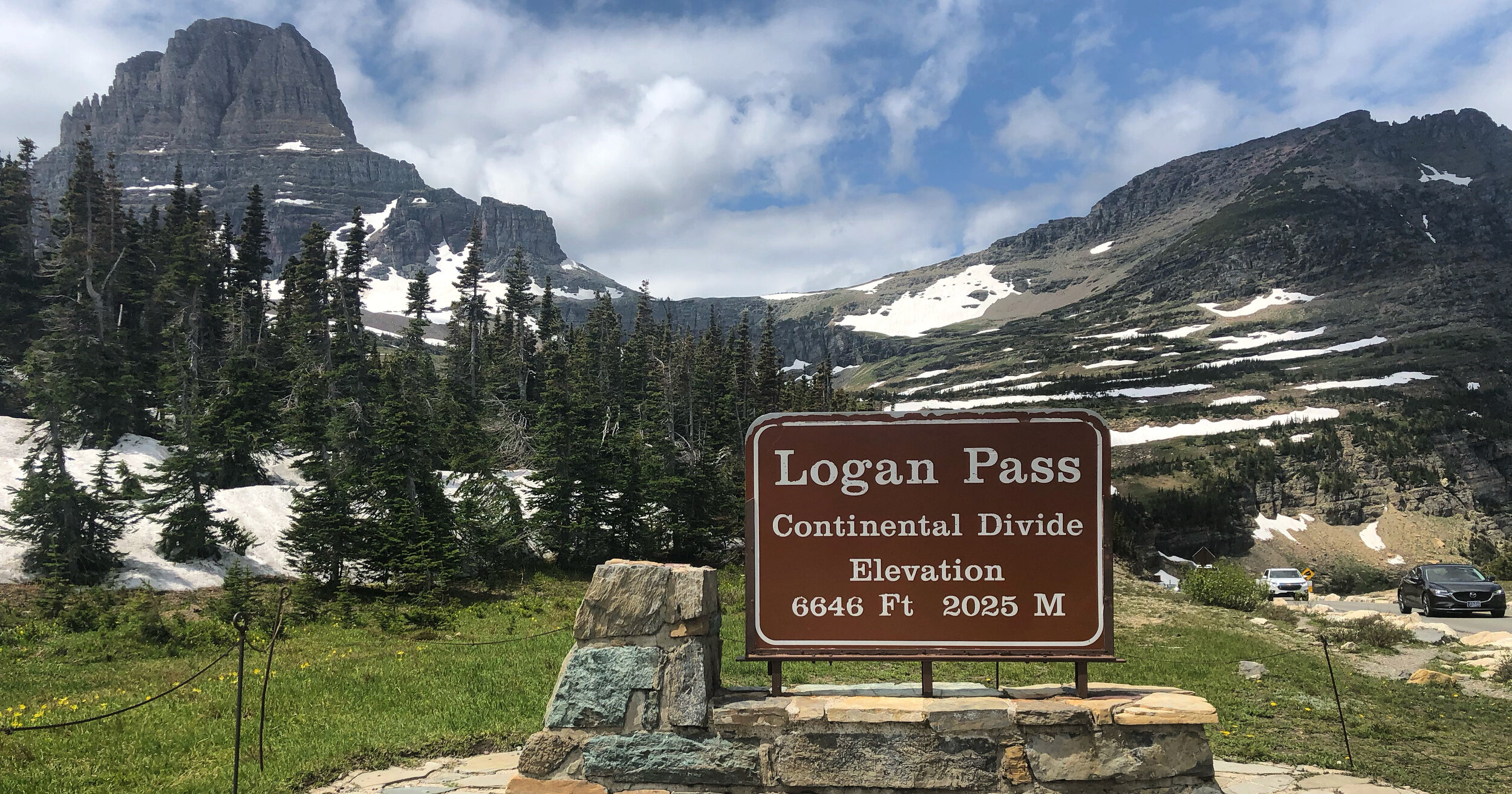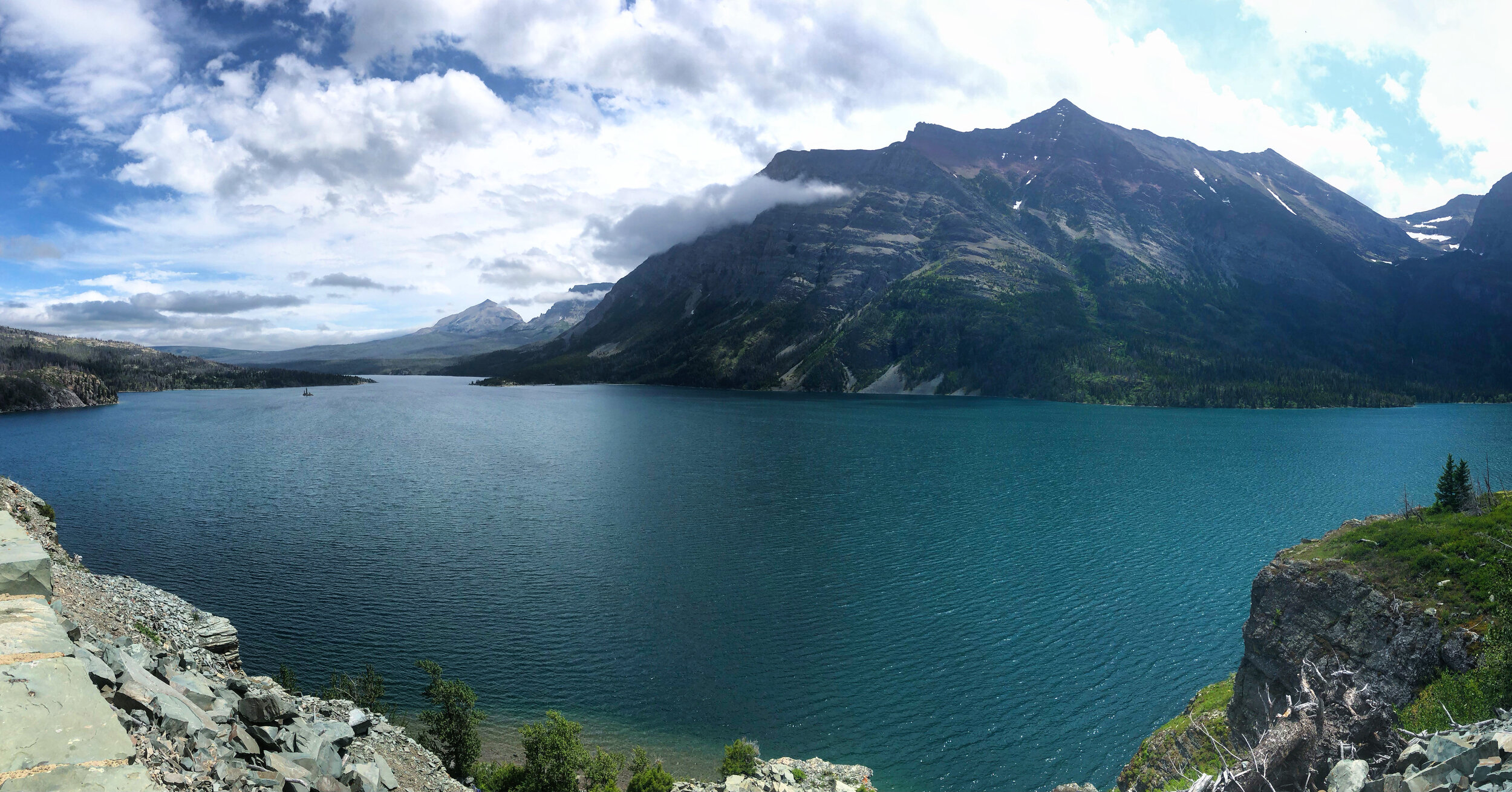National Park Week Feature: Glacier
A teeny-tiny Goose Island pokes out of the pristine, serene waters of St. Mary Lake.
On July 2nd, 2019, with my maps, camera, colored pencils, and Junior Park Ranger booklet in tow, I was ready to ride that iconic road to the sky: Going-to-the-Sun Road. It's only open a few months out of the year. Loads and loads of snow make its joy-riding season incredibly short – from late June or early July through late September – early October. One year it snowed so much, the road wasn't fully reopened until July 13th!
Needless to say, I'd been watching the weather like a hawk and constantly checking the road's plow progress leading up to my visit. But despite their average annual snowfall of 157 inches, Going-to-the-Sun Road was open and ready for riding just in time for my arrival.
I pulled out of the visitor center and onto Going-to-the-Sun Road with my windows way down and my music way up, ready for adventure, and eager to dip my toes into the crystal clear waters of Lake McDonald––the waterscape I'd been dreaming of for years. I was too excited to wait for a parking lot to appear, so I tucked my rental safely within the confines of the road's shoulder, then quite ungracefully staggered my way down a woody hill. I followed the soft sound of small waves washing over the prettiest rainbow rocks I'd ever seen. This park is so beautiful, you'd think it was designed not only by the forces of nature, but by the hands of Bob Ross himself. Snowcapped mountaintops poked over the pine tree skyline, those impossibly colorful pebbles glistened under the soft-spoken, rippled waters, creating an almost inconceivable, no-way-is-this-place-real panorama. So for once in my life, I did exactly what I was "supposed to do." I sat still on a log and just admired the view for a while.
I was feeling my favorite blend of "YEEHAW! LET'S DO THIS!" and "I'm so mellow and at peace" when I slid back into my rental beast and pulled out onto that beautiful black highway. I could hardly wait for all the trees on my right to suddenly drop off and give way to the limitless valley below.
The drive up from Lake McDonald to St. Mary starts you on the daredevil side of the road. With a double-yellow line, a string of cars, and a wall of mountain to your left and nothing but wide-open wilderness plummeting 6,000+ feet to your right, you know you're on the road that looks like it leads to the Sun. But I swear, it sounds scarier than it is. Or maybe it's just as scary as it sounds...depending on how you feel about heights and driving 'round the rim of steep cliffs. Me, I was exhilarated by the experience. However, had the altitude been a few thousand feet higher, I would've been queasy and wheezing and definitely not yeehawing.
Soon, that massive rock wall to my left looked to be about a mile high. It stood stoic with deep excavation marks climbing sideways up the jagged alpine mountain line. And to my right, a marvelous abyss filled with many shades of green, many breeds of trees, rushing rivers, snowy spots, mountain goats, and most definitely some grizzlies, all beneath that 6,000+ foot drop. The only thing between my wheels and the edge of the cliff was a row of rocks, no more than eight inches high. Along some stretches of the road, the rocks were a little taller, in others, there were no rocks at all, and a very brief, very low guardrail might have also appeared here or there, but it could've been a figment of my imagination. It makes sense why there's little protection on the cliff-side of the road. How else would they be able to plow so much snow off the sides of it effectively? Man, would I love to be one of the fellas manning those plows. Actually, no, I wouldn't. Wait, yes, I would. It would be fun to try.
I can't imagine being involved in the actual building of the road, though. Just as Glacier's tourist season is incredibly short, the construction season of Going-to-the-Sun Road was also incredibly short. Cutting into cliffs, moving tons and tons of solid rock – sometimes by hand because power equipment couldn't reach everywhere it was needed. Work like this just couldn't be done in the dead of winter. The men who constructed this road often had to climb 3,000 feet each morning to begin their day of work. It ended up taking $2,000,000 and three decades of planning and constructing for the first vehicle to drive the entire 51 miles of this monumental trans-mountain road.
Many describe the drive as white-knuckling, others call it electrifying, but most will warn you how wild it can be. But so far, driving America's most magnificent road was a lot less nerve-wracking than I expected it to be. Somehow, I wasn't nervous at all even though, in the weeks leading up to my adventure, I'd jacked my nerves up plenty reading all those persuasive scare-and-beware Going-to-the-Sun Road cautionary tales. To my surprise, I felt right at home on that winding mountain road. Where white waterfalls decorate and saturate the pavement, soaking the cars and bikes that pass under them…it feels like driving through a nature-made drive-thru waterpark. The cascades flow from mountaintop to valley floor in an endless pour into the river below. And you can hear the sound of rushing water from inside your car with the windows up. But pull over at one of the many scenic overlooks to turn the volume up way high.
Cars begin to cluster the closer they get to Logan Pass. All sorts of vehicles were parked legally and illegally in every space that could even remotely fit one. I drove laps around the lot over and over, watching swarms of people flood in and out of the visitor center. But no one exiting the building was heading for their car. They were all off to hike the nearby, semi-closed-due-to-snow trails.
I felt a little guilty doing it, given the fact that I was going to become a Junior Park Ranger that day, and I really try to treat every park with the utmost care and respect, but I was parking my rental wherever I thought it wouldn't get rear-ended. Because after a few hours of driving and about 30 minutes of circling, my morning breakfast bar had long worn off, and the two bottles of water I'd slugged were ready to be released. So I parked at the very end of a trail of illegally parked cars on some semblance of the ramp's shoulder. It was quite the steep trek up from my car, and I had a bit of pep in my step because I was afraid some handsome ranger was going to catch me in the act of parking illegally, and I'd be ashamed and have to pee my pants and move my car.
I made my way to the ladies' room then found myself strolling through aisles of NPS goodies, suddenly with arms full of souvenirs. Where did these come from? I brought them to the register as it seemed to be the only viable option. Might as well get all my goodies before I get my lunch, I thought. I was starving, and operation turkey sandwich was the name of my hunger game. National parks always have them. Shouldn't be hard to find. I could practically taste it. But there was no such lunch to be had at the Logan Pass Visitor Center. They have no food there! I knew this! I researched this, wrote it down, made a mental note of it, might have even told a friend or two about it. But all of this went out the window and drowned in one of the glorious snow-fed lakes I'd passed along the way. Or even before that, when I somehow forgot to pack myself a lunch at the hotel that morning. I couldn't believe it. How could I forget? Too eager to hit the road and be in the park, no doubt.
"Yeah, we really can't keep any food up here. We're just too deep in the wilderness…the bears …they'd smell it out and––what's that, miss? No, sorry, not even a vending machine. But if you head a bit further up the road to Rising Sun––that's before St. Mary––they've got a restaurant up there."
Well, I figured, since I've come this far and I'm SO hungry, I might as well head to Rising Sun. And since I'll be that far, I might as well head to St. Mary too––drive that whole stretch of high mountain road, then do it all over again in reverse. I knew I'd at least get up to Logan Pass, but I wasn't sure I'd make it all the way to St. Mary. That'd put me at a 4.5-hour roundtrip journey.
But what I really wanted to do was not only drive to St. Mary, but also make my way up to Many Glacier then follow the Chief Mountain International Highway into Canada's Waterton Lakes National Park, then back down to my hotel 45 minutes south of Glacier's park entrance. All in all, at least a 10-hour excursion with barely any time not behind the wheel, so that wasn't happening. Glacier is a park you could easily spend at least a week in, but I only had till sundown, so I scurried out of the visitor center to find my car, and I was stopped dead in my tracks by the movement of the clouds above me and how insanely low they were. They reminded me of the smoke that hovers above a cauldron being whirled and twirled into some magical elixir.
In New York City, you can watch the world go by and see strange and thought-provoking things. In Glacier National Park, you can watch the clouds go by and see storms brew, and if you're lucky, maybe even a rainbow or two. And if you hang around Logan Pass long enough, that's precisely what you'll find because it straddles the Continental Divide. That's where the rival winds of the Arctic meet those of the Pacific, providing the perfect turf for extreme and unpredictable weather. During winter, Logan Pass can accumulate snow up to eight stories high. Glacier National Park once had as many as 150 glaciers, some up to 2 miles thick! Today there are only 25 left.
I made my way, back onto that gorgeous, precious highway, stopped at the Jackson Glacier overlook to appreciate its existence. And then I quite accidentally, but very delightfully found the sight featured in my photo above: that classic, Goose-Island-sitting-in-the-middle-of-St.-Mary-Lake shot that I only had to climb like two massive boulders to find. I was thrilled! Almost forgot how hungry I was. But a couple miles up the road, as promised, I found the restaurant at Rising Sun.
It was a lovely place. I highly recommend giving it a try. It wasn't dressy by any means, but it felt more upscale than what I'm used to finding in a national park. Cold cut sandwiches in paper bags, squeeze-packet mayo and mustard, exquisite fountain sodas…that's what I'm used to. And that's what I was craving. But this place had a classy menu, classy tables, classy chairs – however, it did not have the classic turkey club sandwich that I'd already decided I needed to have. Words like "bratwurst, Angus roast beef, wagyu beef, and smoked pork belly" were on the menu. And while most people I know would say, "You kiddin' me, Laur? Screw the sandwich you've no doubt eaten the last six days in a row, and treat yourself to some grade-A beef!" But me, I'm more of a plain Jane, play-it-safe-and-have-one-of-the-nine-foods-I-normally-eat kinda gal. So I bought some more souvenirs, had a lovely chat with a Xanterra employee about how to become a seasonal worker in the parks, then I decided to head up to St. Mary. Might as well go all the way, right?
As fate would have it, I found my turkey club at another lovely restaurant called the Snowgoose Grille, and I even got some help answering a few of the tougher questions in my Junior Park Ranger booklet from my kind waiter. Don't let the fact that those books are made for kids fool you! Some of the questions in there are genuinely challenging. Of course, there are even more fun-to-figure-out tasks that I enjoyed while finishing up some fries. Stuff like parks and nature-related crossword puzzles, word search games, spaces for drawing what you see, and writing about things you've learned.
Once my lunch was gone and my booklet was complete, I headed into the visitor center to find a ranger. I stamped my National Parks Passport because first things first. Then I asked a pretty ranger lady a few questions that'd been brewing in my brain for a while. I also asked if she'd look over my workbook and swear me in. And indeed she did. She also awarded me my third Junior Park Ranger badge of the trip, which I proudly wore as I headed back the way I came on Going-to-the-Sun Road.
On the drive back from St. Mary, I cruised comfortably tucked along the inside wall. I jammed out and reflected on my journey through the Crown Jewel of the Continent. That's what it's known as and rightfully so. Not only is it breathtaking at every turn, but it also helped carve over half of North America. Glacier National Park is a place where you feel small in a big way. It's a place to be totally taken by natural wonders and humbled by the magnitude of man's engineering feat: the creation of Going-to-the-Sun Road. It's a place for childlike wonder and new discoveries. It's a place I hope everyone gets to see at least once in their lifetime.
